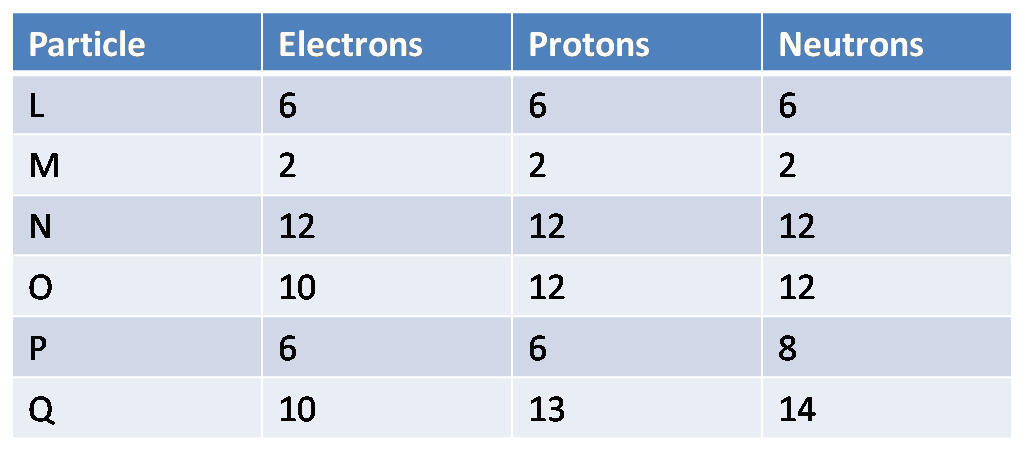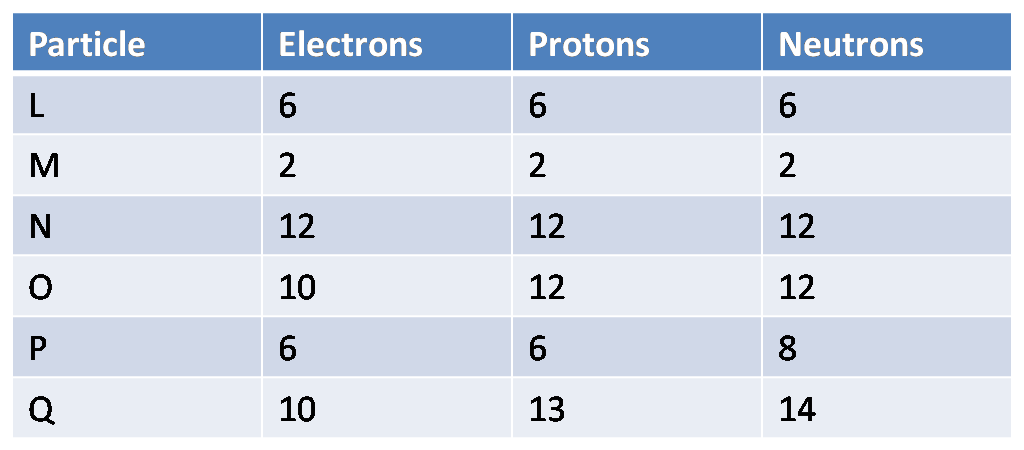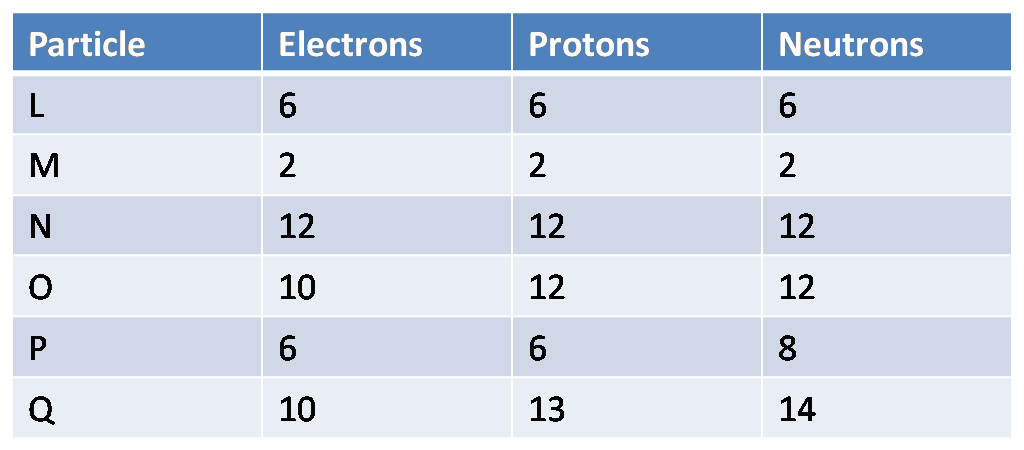Atomic Structure: Isotopes & Ions

Dear all, Hope you all had a light-hearted first lesson with me. Do this quiz and check how much you've learnt and most importantly, try applying concepts to the questions. Have fun!
love, MsKhoo
- 1.
How do I form Li+?
- A.
Add one electron
- B.
Remove one proton
- C.
Remove one electron
- D.
Add one neutron
Correct Answer
C. Remove one electronExplanation
How do you remove protons or neutrons from the nucleus? That requires a HUGE HUGE amount of energy..Rate this question:
-
- 2.
Fe 2+ and Fe3+ are different __________.
- A.
Ions
- B.
Isotopes
- C.
Elements
- D.
Atoms
Correct Answer
A. IonsExplanation
Fe2+ and Fe3+ are different ions because they have different charges. Fe2+ has a +2 charge, meaning it has lost two electrons, while Fe3+ has a +3 charge, indicating the loss of three electrons. This difference in charge is what distinguishes them as separate ions.Rate this question:
-
- 3.
Cu2+ and Zn2+ are examples of ________.
- A.
Anions
- B.
Cations
- C.
Isotopes
- D.
Molecules
Correct Answer
B. CationsExplanation
Cu2+ and Zn2+ are examples of cations because they are positively charged ions. Cations are formed when an atom loses one or more electrons, resulting in a net positive charge. In the case of Cu2+ and Zn2+, these ions have lost two electrons each, giving them a +2 charge. Anions, on the other hand, are negatively charged ions that have gained one or more electrons. Isotopes are different forms of the same element with varying numbers of neutrons, and molecules are combinations of atoms held together by chemical bonds.Rate this question:
-
- 4.
Which is the correct symbol for the element with 8 protons and 10 electrons?
- A.
N3-
- B.
O2-
- C.
O3-
- D.
F-
Correct Answer
B. O2-Explanation
The correct symbol for the element with 8 protons and 10 electrons is O2-. This is because oxygen (O) has 8 protons in its nucleus, and in a neutral atom, it would also have 8 electrons. However, in this case, there are 10 electrons, indicating that the atom has gained 2 extra electrons. When an atom gains electrons, it becomes negatively charged, and the symbol is represented with a superscript minus sign. Therefore, O2- is the correct symbol for the element with 8 protons and 10 electrons.Rate this question:
-
- 5.
Which is the correct symbol for an O atom with 8 protons, 9 neutrons and 8 electrons?
- A.
16 O 8
- B.
17 O 8
- C.
18 O 8
- D.
18 O 9
Correct Answer
B. 17 O 8Explanation
The symbol "17 O" represents an oxygen atom with 8 protons, 9 neutrons, and 8 electrons. The atomic number of an element corresponds to the number of protons in its nucleus, so the atomic number of oxygen is 8. The mass number of an element is the sum of its protons and neutrons, so the mass number of this oxygen atom is 17. Therefore, the correct symbol for this oxygen atom is "17 O" with 8 protons, 9 neutrons, and 8 electrons.Rate this question:
-
- 6.
How many electrons does Li+ atom have?
- A.
0
- B.
1
- C.
2
- D.
3
Correct Answer
C. 2Explanation
The Li+ atom is a positively charged ion, indicating that it has lost one electron. Since a neutral lithium atom has 3 electrons, the Li+ ion will have 2 electrons remaining after losing one.Rate this question:
-
- 7.
How many protons, neutrons and electrons does Be2+ have?
- A.
4,3,2
- B.
4,3,4
- C.
4,3,6
- D.
4,4,2
Correct Answer
A. 4,3,2Explanation
Beryllium (Be) has an atomic number of 4, which means it has 4 protons. The Be2+ ion indicates that it has lost 2 electrons, resulting in a charge of +2. Since protons and electrons have the same magnitude of charge but opposite signs, the number of electrons is 2 less than the number of protons, giving us 2 electrons. The number of neutrons in an atom or ion can be calculated by subtracting the atomic number from the mass number. However, the question does not provide the mass number, so the number of neutrons cannot be determined. Therefore, the correct answer is 4,3,2.Rate this question:
-
- 8.
N3- has __________.
- A.
7 protons and 4 electrons
- B.
7 protons and 10 electrons
- C.
7 protons and 11 electrons
- D.
8 protons and 11 electrons
Correct Answer
B. 7 protons and 10 electronsExplanation
p = e ; the number of protons equates the number of electrons when the atom is electrically neutral. In this case, 3 electrons was added to give nitrogen the overall -3 charge.Rate this question:
-
- 9.
The table shows the atomic structure of 6 particles, represented by the letters L to Q. The particles are atoms or ions. The letters are not the symbol of the elements. Which 2 particles are ions?
Correct Answer
O and Q
O & Q
o and q
o & qExplanation
Yes they have the same number of protons but different number of electrons.Rate this question:
- 10.
Which particle is an atom of a noble gas?
Correct Answer
M
mExplanation
Noble gases have full electronic configuration. In this case, M has an electronic configuration of 2.8.Rate this question:
- 11.
Which two particles are an atom and an ion of the same element?
Correct Answer
N and O
N & O
n and o
n & oExplanation
N and O have the same proton number belonging to Magnesium.If u chose L and P, they are an example of an isotope.Rate this question:
- 12.
Which two particles are isotopes of the same element?
Correct Answer
L and P
L & P
l and p
l & pExplanation
Isotopes are atoms of the same element that have the same number of protons but different number of neutrons. Therefore, L and P, L & P, l and p, and l & p are all correct answers because they represent pairs of particles that are isotopes of the same element.Rate this question:
- 13.
Which particle has the highest atomic mass?
Correct Answer
Q
qExplanation
The particle with the highest atomic mass is Q. The lowercase q is not a particle and does not have an atomic mass. Atomic mass refers to the mass of an atom, which is determined by the number of protons, neutrons, and electrons it contains. Since q is not a recognized particle, it does not have an atomic mass. Therefore, Q is the correct answer.Rate this question:
Quiz Review Timeline +
Our quizzes are rigorously reviewed, monitored and continuously updated by our expert board to maintain accuracy, relevance, and timeliness.
-
Current Version
-
Mar 21, 2023Quiz Edited by
ProProfs Editorial Team -
Mar 01, 2010Quiz Created by
Khoocarolyn
 Back to top
Back to top






